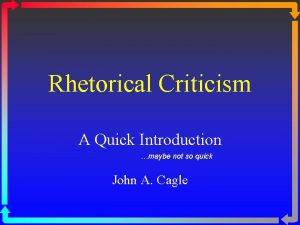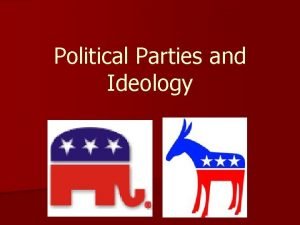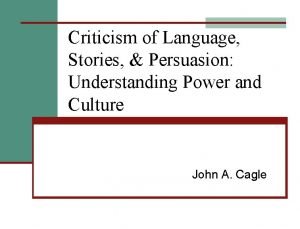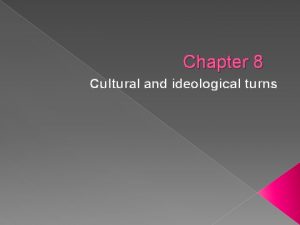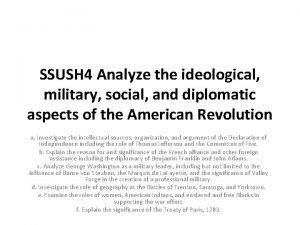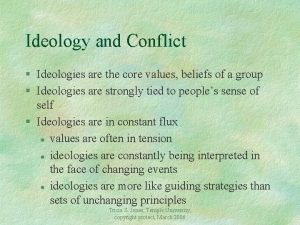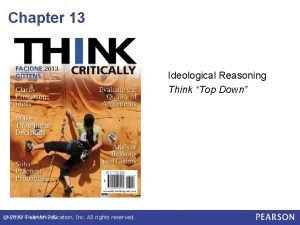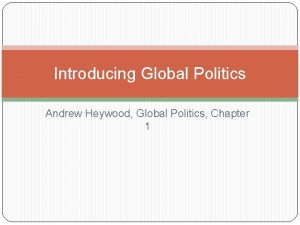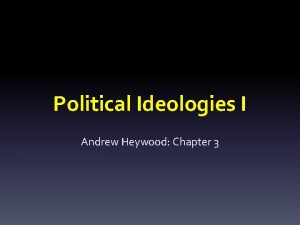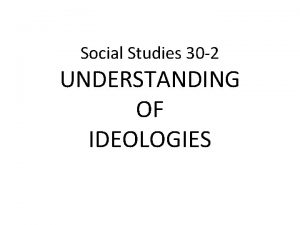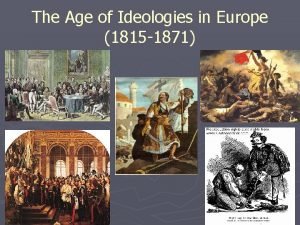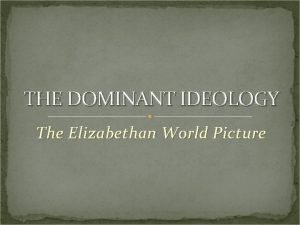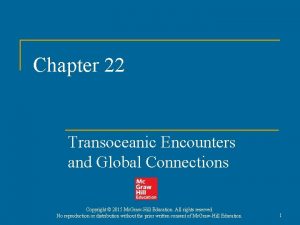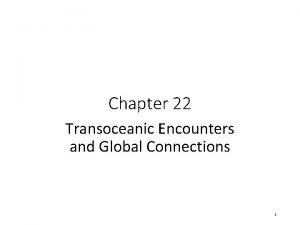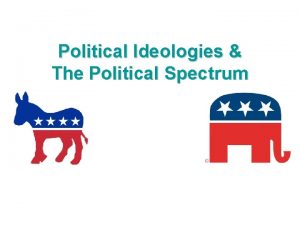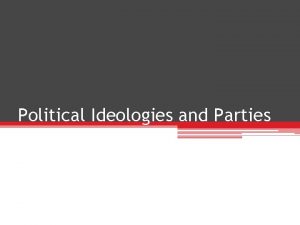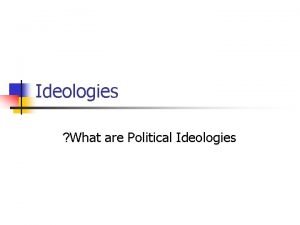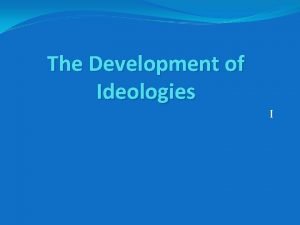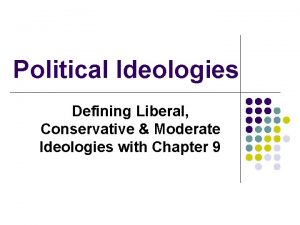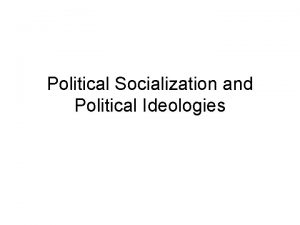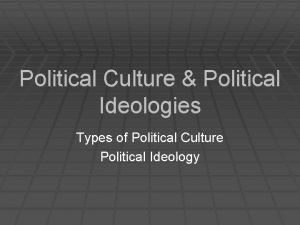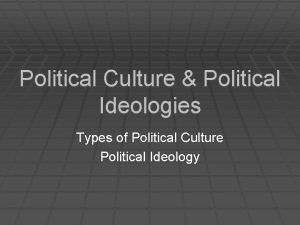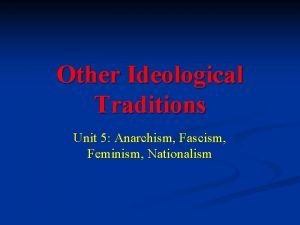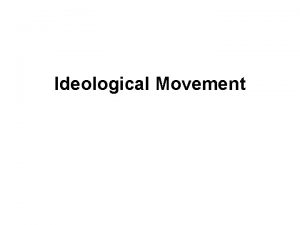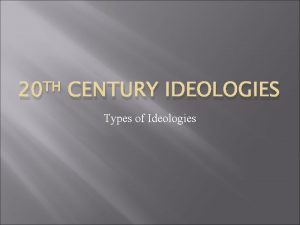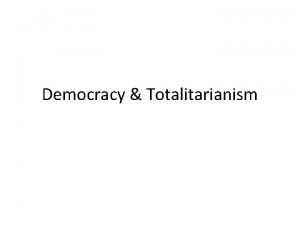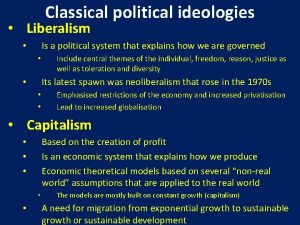Political Ideologies II Other Ideological Traditions Heywood Chapter




























- Slides: 28

Political Ideologies II Other Ideological Traditions Heywood: Chapter 3

Other Ideological Traditions 1 - Fascism Whereas liberalism, conservatism and socialism are 19 th century ideologies, fascism is a child of the 20 th century. Some would say that it is specifically an inter-war phenomenon. Although fascist beliefs can be traced back to the late 19 th century, they were fused together and shaped by the World War I and its aftermath, and in particular by the potent mixture of war and revolution that characterized the period.

Other Ideological Traditions 1 - Fascism In many respects, fascism constituted a revolt against the ideas and values that had dominated western political thought since the French Revolution.

Other Ideological Traditions 1 - Fascism Values such as rationalism, progress, freedom and equality were thus overturned in the name of struggle, leadership, power, heroism and war. In this sense, fascism has an 'anticharacter'. It is defined largely by what it opposes: it is a form of anticapitalism, anti-liberalism, anti-individualism, anti-communism, and so on.

Other Ideological Traditions 1 - Fascism A core theme that runs throughout fascism is the image of an organically unified national community. The individual, in a literal sense, is nothing; individual identity must be absorbed entirely into that of the community or social group. The fascist ideal is that of the 'new man', a hero, motivated by duty, honour and self-sacrifice, prepared to dedicate his life to the glory of his nation or race, and to give unquestioning obedience to a supreme leader.

Anarchism The central theme is the belief that political authority in all its forms, and especially in the form of the state, is both evil and unnecessary (anarchy literally means 'without rule'). Nevertheless, the anarchist preference for a stateless society in which free individuals manage their own affairs, through voluntary agreement and cooperation has been developed on the basis of two rival traditions: Liberal Individualism, and Socialist Communitarianism.

Anarchism can thus be thought of as a point of intersection between liberalism and socialism: 'ultraliberalism' and 'ultrasocialism’. a form of both

Feminism Although feminist aspirations have been expressed in societies dating back to Ancient China, they were not underpinned by a developed political theory until the publication of Mary Wollstonecraft's “A Vindication of the Rights of Women” [1792]. Indeed, it was not until the emergence of the women's suffrage movement in the 1840 s and 1850 s that feminist ideas reached a wider audience, in the form of so-called 'first-wave feminism'.

Feminism The achievement of female suffrage in most western countries in the early 20 th century deprived the women's movement of its central goal and organizing principle. 'Second-wave feminism’, emerged in the 1960 s. This expressed the more radical, and sometimes revolutionary, demands of the growing Women's Liberation Movement (WLM).

Feminism Feminist theories and doctrines are diverse, but their unifying feature is a common desire to enhance the social role of women. The underlying themes of feminism are: a) society is characterized by sexual or gender inequality. b) this structure of male power can and should be overturned.

Feminism At least three contrasting feminist traditions can be identified. 1) Liberal feminists, such as Wollstonecraft and Friedan, have tended to understand female subordination in terms of the unequal distribution of rights and opportunities in society. This 'equal-rights feminism' is essentially reformist. It is concerned with enhancing the legal and political status of women and improving their educational and career prospects.

Feminism 2) Socialist feminists emphasize the links between female subordination and the capitalist mode of production. It draws attention to the economic importance of women being confined to a family or domestic life where they, for example, relieve male workers of the burden of domestic labour, rear and help to educate the next generation of capitalist workers, and act as a reserve army of labour.

Feminism 3) The distinctive flavour of second-wave feminism results mainly from the emergence of radical feminism. Radical feminists believe that gender divisions are the most fundamental and politically significant cleavages in society. In their view, all societies, historical and contemporary, are characterized by patriarchy, the institution whereby, as Kate Millett put it, 'that half of the population which is female is controlled by that half which is male’.

Feminism • Radical feminists therefore proclaim the need for a sexual revolution, a revolution that will, in particular, restructure personal, domestic and family life.

Environmentalism Although environmentalism is usually seen as a new ideology that is linked to the emergence of the ecological, or Green, movement in the late 20 th century, its roots can be traced back to the 19 th -century revolt against industrialization.

Environmentalism therefore reflects concern about the damage done to the natural world by the increasing pace of economic development (worsened in the second half of the 20 th century due to nuclear technology, acid rain, ozone depletion, global warming and so on), and anxiety about the declining quality of human existence and, ultimately, the survival of the human species.

Environmentalism What gives environmentalism its radical edge is the fact that it offers an alternative to the anthropocentric or human-centred stance adopted by all other ideologies; it does not see the natural world simply as a convenient resource available to satisfy human needs.

Environmentalism By highlighting the importance of ecology, environmentalism or, as some of its proponents would prefer to call it, ecologism develops an ecocentric world view that portrays the human species as merely part of nature.

Religious fundamentalism views politics (and indeed all aspects of personal and social existence) as being secondary to the 'revealed truth’ of religious doctrine. From this perspective, political and social life should be organized on the basis of what are seen as essential or original religious principles, commonly supported by a belief in the literal truth of sacred texts. As it is possible to develop such principles into a comprehensive world view, religious fundamentalism can be treated as an ideology in its own right.

Religious fundamentalism Where does religious fundamentalism come from, and what explains its resurgence at the end of the 20 th century? 2 contrasting explanations have been advanced. One views fundamentalism as essentially a symptom of the adjustment that societies make as they become accustomed to a modern and secularized culture.

Religious fundamentalism The second suggests that fundamentalism is of enduring significance, and believes that it is a consequence of the failure of secularism to satisfy the abiding human desire for 'higher' or spiritual truth.

Religious fundamentalism Forms of religious fundamentalism have arisen in various parts of the world. The significance of Christian fundamentalism, for example, has increased in the USA since the 1970 s as a result of the emergence of the 'New Christian Right', which campaigns against abortion, and for the introduction of prayers in US schools and a return to traditional family values.

Religious fundamentalism In Israel, Jewish fundamentalism, long represented by a collection of small religious parties, has grown in importance as a result of attempts to prevent parts of what are seen as the Jewish homeland being seceded to an emerging Palestinian state. Hindu fundamentalism in India has developed to resist the spread of western secularism, and to combat the influence of rival creeds such as Sikhism and Islam.

The end of ideology? Much of the debate about ideology in the late 20 th century focused on predictions of its demise, or at least of its fading relevance. This came to be known as the 'end of ideology' debate. It was initiated in the 1950 s, stimulated by the collapse of fascism at the end of the Second World War and the decline of communism in the developed West.

The end of Ideology? In “The End of Ideology? : On the Exhaustion of Political Ideas in the 1950 s” (1960), the US sociologist Daniel Bell declared that the stock of political ideas had been exhausted.

The end of ideology? In his view, ethical and ideological questions had become irrelevant because in most western societies parties competed for power simply by promising higher levels of economic growth and material affluence. In short, economics had triumphed over politics.

The end of ideology? However, the process to which Bell drew attention was not so much an end of ideology as the emergence of a broad ideological consensus amongst major parties that led to the suspension of ideological debate. (The ideology that prevailed in the 1950 s and 1960 s was a form of welfare capitalism, which in the UK and elsewhere took the form of a Keynesian-welfarist consensus).

The end of ideology? The very assertion of an end of ideology, an end of history, or an end of modernity can be seen as ideological in itself. Rather than heralding the final demise of ideology, such assertions may only demonstrate that ideological debate is alive and well, and that the evolution of ideology is a continuing and perhaps unending process.
 Two dimensions of political ideologies
Two dimensions of political ideologies Political ideology definition ap gov
Political ideology definition ap gov Political ideologies cows
Political ideologies cows Ideological criticism
Ideological criticism Define ideological parties
Define ideological parties Ideological criticism
Ideological criticism Cultural and ideological turns
Cultural and ideological turns Four cornered ideological grid
Four cornered ideological grid Ssush4 analyze the ideological military
Ssush4 analyze the ideological military Polyhydromnios
Polyhydromnios Ideological conflict definition
Ideological conflict definition Ideological reasoning examples
Ideological reasoning examples Ideological reasoning examples
Ideological reasoning examples Andrew heywood comparative politics
Andrew heywood comparative politics A 1017
A 1017 Heywood hospital lab
Heywood hospital lab Elements of liberalism according to heywood
Elements of liberalism according to heywood Recovery republic heywood
Recovery republic heywood Trainspotting ideologies
Trainspotting ideologies Discourse and ideology
Discourse and ideology Social 30-2 module answers
Social 30-2 module answers Obsolescent frontier'' civilization diagram
Obsolescent frontier'' civilization diagram Curriculum ideologies
Curriculum ideologies An age of ideologies
An age of ideologies Primogenity
Primogenity Chechynia
Chechynia An age of ideologies
An age of ideologies Chapter 22 traditions and encounters
Chapter 22 traditions and encounters Chapter 22 transoceanic encounters and global connections
Chapter 22 transoceanic encounters and global connections



